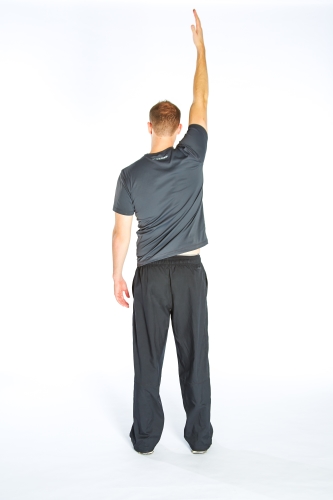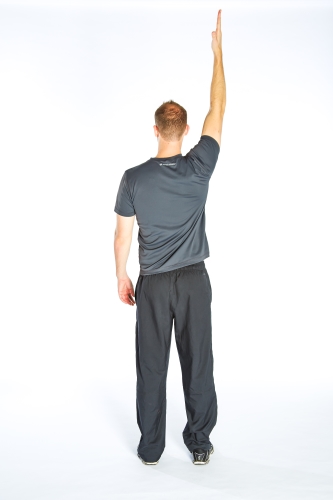Overhead work such as overhead press, overhead squat, clean and jerk, snatch, and even pulldowns and chin ups requires one thing above all – shoulder mobility. The reason is, to get the most out of overhead training, you have to be able to get your arms straight up and down. Without that ability, you will be missing out on benefits and be at a higher risk for injury.
Get The Weight Over The Shoulders

Weight Over Shoulders
At the top of an overhead movement you want the weight to be aligned directly over your shoulders. This is the most stable position because your entire body is then directly under the weight. If the weight is slightly foward, you lose that stability and your shoulders end up doing much more work than they should, which could be dangerous.
You may find that it is difficult to get your arms perfectly vertical. Many of us have stiff muscles in the neck, shoulder, and upper back and these muscles might not be moving as they should. If you are having difficulty a coach, personal trainer, or physical therapist should be able to help you decrease restrictions and increase your mobility. Try seeking one out in your area.
Pulling From An Overhead Position
Remember that exercises like lat pulldowns or chin ups are also overhead movements. In these, you might not have your arm quite as vertical, but they will still be overhead and you will need the shoulder mobility. Again, if you find it difficult to get your arms vertical, you may need to loosen up some areas and work on restoring shoulder mobility.
Watch Out For Compensations
Stiffness around joints will cause some strange movements to occur. With overhead work, one of the most common is excessive shrugging at the top of the movement. To check for this compensation stand in front of a mirror and raise one arm. If you see your shoulder come very close to your ear, then you may need to work on your shoulder mobility. The picture on the left shows this compensation, the picture on the right shows a better position.
Why It Matters – Strength And Injury Prevention
The most common surgeries involve muscles and joints1 and shoulder problems are common part of this trend.2 One of the reasons for this is the prevalence of shoulder stiffness and immobility. When you keep your shoulders moving well—up to and including the overhead position—you can train with proper form which keeps the muscles in good condition and you out of the orthopedist’s office.
You will also be stronger. Optimal alignment means optimal stability and that means more strength. You may even find that you can push past a sticking point in your program simply by doing a little mobility work.
Related
How Movement Quality Beats Movement Quantity


